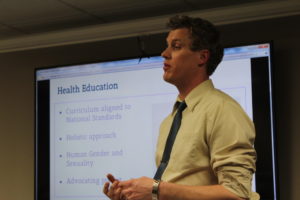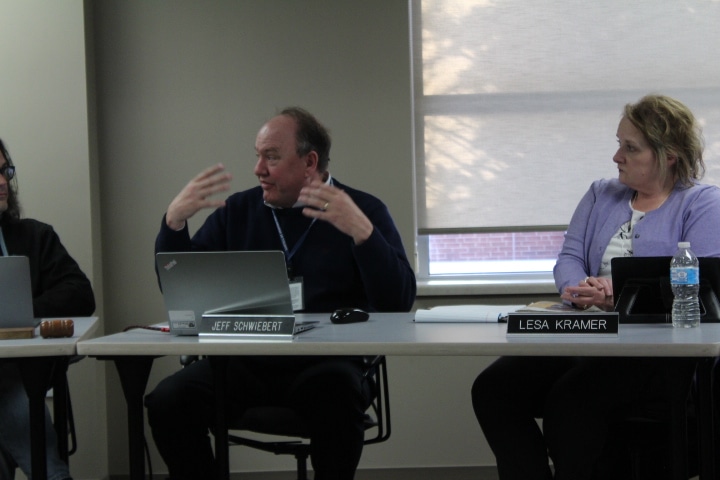by Dave DeMars
news@thenewsleaders.com
The Sartell St. Stephen school board held its regular monthly meeting on April 16 with most of the meeting being taken up by reports. Of key concern was the report on the progress of the new high school.
Lee Gruen, project manager at Winkelman Building Corp., related how the latest round of inclement weather has affected the building progress of the new high school. The projected date for full enclosure of the building was June 21. That has been pushed back to July 21 because of the weather.
Gruen told the board they had projected warmer weather would arrive in March allowing for a speed up in concrete pours, but that has not materialized. The snow and cold weather have also caused muddy conditions on site and a longer drying period for field work on playing fields. The hope of having sports fields in shape for cutting and care in the fall may not be realized and that could potentially affect spring sports.
“We don’t have concerns about being done on time, but we are going to have to stack trades – having the same contractor work in multiple areas,” Gruen told the board. “The big picture is the weather is terrible and we are all tired of it, but at the end of the day, we will finish on time.”
Progress on the building has continued despite the snows, Gruen reported. Precast walls are complete in the theater, gym and pool for the most part. Structural steel has been completed in several areas and the balcony
steel and catwalk in the theater area are complete. Roofing of the theater is complete. The concrete slab for the theater stage has been poured, and pours in the pool area are scheduled to be made in the upcoming weeks. Electrical and plumbing work continues apace.
The budget for the building continues to be on track and balanced.
Gruen also reported there was a minor fire at the site. No damage was done to the building, and no personnel were injured. The problem was caused by an unattended tar pot which is used in the roofing process. The issue has been addressed and in the future one person will be assigned to monitor the tar pots to prevent any recurrence of the problem.
Superintendent’s report
Superintendent Jeff Schwiebert addressed several issues, the first being concerns that have been raised as a result of a second-grade student in Sauk Rapids attacking other students with a knife at school.
“I think we all just need to understand there will be a lot of talk in the news about it, and a lot of people will be asking what is our policy,” Schwiebert said. “Our policies are very similar to Sauk Rapids.”
Schwiebert went on to say he has no more information than others who watch the news. He highlighted the fact the district has provided ALICE training (Alert, Lock-down, Inform, Counter, Evacuate) for teachers and personnel so they would know how to react in such an event.
“Sometimes when we talk about our ALICE training we make the statement it’s always a stranger, or seem to think it implies it’s a stranger, but really ALICE training is for anyone doing anything inappropriate that is causing other students to be at risk,” Schwiebert said.
While at the senior high level, it’s often supposed the violator may well be another student, that is seldom the case at the primary level, Schwiebert commented. That misconception will be addressed in the coming weeks, he said.
The second issue Schwiebert addressed was a remark he made at the last board meeting he termed as “inappropriate.”
“I made a comment and it was repeated by the Newsleader – I made it, so I’m not blaming the Newsleader – that kids are different today,” Schwiebert said. “Kids aren’t different today. Their behaviors are different today.”
Schwiebert said a teacher rightfully reminded him kids aren’t different, but that behaviors are different.
“It isn’t the kids who are different, but sometimes the behaviors they do are different,” Schwiebert said.
In reference to another security concern, Schwiebert said he and members of the board had met with the Sartell police chief and some members of city government and discussed what could be done to make district buildings more secure and safe.
One idea offered was having police officers visit schools on a more or less regular basis. Schwiebert said the police chief was supportive of that idea. He said he had e-mailed the staff about that possibility and that is now happening.
He also commented the police chief strongly advocated all staff wear their district-issued ID badges so they would be known and easily distinguished from troublemakers in a building.
Finally, Schwiebert summarized the enrollment projections saying there is little difference in the numbers reported in previous meetings, but he cautioned a number that does not appear is the enrollment size of the incoming kindergarten class.
“It is one of my biggest pains,” said Schwiebert, “to try to get that number so I know exactly what it is. It has such an implication on (future) staffing.”
Building program report
Carl Schwarnweber, physical education and health teacher; Roy Snyder, coach and social studies teacher; Nick Peterson, assistant principal; and Ryan Hauge, activities director; made a presentation to the board on the impacts of health and physical activities education, and where the future might lead.
Schwarnweber told the board during the last several years, the physical education and health department had been working on making sure curriculum conformed with the national standards in physical education and health.
“We have a growing and expanding section in mental and emotional health which is a prominent factor for schools and students these days,” Schwarnweber said, “as well as environmental health that is spread out throughout the curriculum.”
Part of the focus is on gender identity and clarification of definitions because there seems to be inaccurate definitions of many terms related to sexuality, Schwarnweber continued. Another part of the program is called health advocacy in which students research, learn and advocate for behaviors which enhance personal health.
In physical education, the goal is to get more students involved in physical activity. Part of the program is involved in establishing new standards that align with the state of Minnesota. Also included are new ways of grading physical education students. Included is also a new emphasis on technology.
The program is districtwide.
A portion of the report dealt with how the new facilities and equipment in the new high school might impact the physical-education program. One highlight was the expansion of size of the facility which will allow for multiple classes using the same space area without infringing on one another’s space. A new weight room will allow for more and better training.
Layout of baseball fields and practice areas as well as shower rooms will allow for better monitoring of students. Rather than just an athletic-training facility, this new area has more of a community emphasis with a personal-wellness emphasis.

Sartell-St. Stephen Superintendent Jeff Schwiebert enthusiastically makes a point about the building program. Board member Lesa Kramer looks on.

Karl Schwarnweber, physical education and health teacher, highlights what has been happening in that program, and the plans for the program when the new high school is completed.



